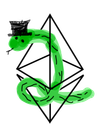Ethereum's Untapped Potential
Author: Marc Garreau
What does success look like for Ethereum?
In a word: adoption. Ethereum will be used when and where it solves a problem. The more problems it solves or opportunities it creates, the greater the adoption.
How then do we optimize for adoption? Lower the barriers to entry. The easier it is to understand or contribute to the protocols and developer tools, the more quality contributions we’ll get. The better the tools and their documentation gets, the easier it is to build on Ethereum. A virtuous cycle is born: better tools lead to more developers, and more developers lead to better tools and more innovative dapps.
Ethereum needs more of us focused on lowering barriers to entry.
The code and conversations all happen in the open, but the developer on-ramp can be steep. In the case of protocol development, engineers and researchers need specialized skills and a ton of context, so direct mentorship is appropriate. The Core Developer Apprenticeship Program (CDAP) was created for this purpose and is off to a very encouraging start. Cohort #2 is open for applications now! (Update: this is now called the Ethereum Protocol Fellowship.)
Building developer tools and dapps on Ethereum isn’t a walk in the park either, but they're much more approachable on average. As a result, onboarding developers is more scalable in these domains. Written and recorded content is polished and published on a daily basis, which helps newcomers get off the ground, but it’s not nearly enough.
There are massive reservoirs of untapped potential.
For open source networks like Ethereum, the rising tide effect is profound. An improvement in Ethereum’s user experience can improve the bottom line of an entire industry, and these contributions can come from anywhere. Certainly the Ethereum Foundation should do its part, but additionally, every crypto company with the means should aim to improve those public goods or enable others to do so.
Note that my definition of public goods includes the open source tools we all rely on, but additionally any free content that users are onboarded into Ethereum with. Our industry shares the responsibility of guiding newcomers through the implications of holding private keys and participating in this network. One company, successful at gently onboarding new Ethereum users, lifts all boats.
If you’re in a position to, consider any of the following starting points:
- Share your learnings. Knowing about an obscure feature of an open source library is not a competitive advantage. Instead, share the usage pattern in a blog post.
- Improve the onboarding and usage documentation of libraries you use.
- Contribute content to ethereum.org.
- Sponsor tools you rely on, monetarily or with developer hours.
- Open source your tools.
- Double down on the documentation of your open source product. Be thorough in your issue details and utilize tags, e.g., `good first issue`.
- Don’t bury all your hard work in release notes. Walk through new features or optimizations in a blog post or conference talk.
- Hire full-time developer [relations/evangelists/advocates] or explicitly grant existing devs the time to create content and meet users where they are.
- Don’t rely on external parties to educate your users. Explain fundamental web3 concepts or security best practices in a shareable medium.
- Lobby your organization to share its learnings publicly or permit contributions to public goods on the clock.
- Share and celebrate efforts made towards public goods from around the industry.
- Join communities that share these priorities, e.g., BuidlGuidl, Developer DAO.
Doing any of this already? Write about it and why it’s important to you. I’ll do my part to amplify your message. Let’s raise the tide.

